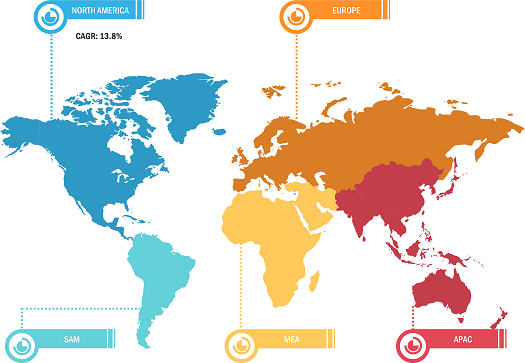Environmental Impact of Livestock Industry and Acceptance of Sustainable Food Habits Favor Plant-Based Ham Market Growth
According to our latest study on “Plant-Based Ham Market Forecast to 2028 – COVID-19 Impact and Global Analysis – by Product Type and Distribution Channel,’’ the market is expected to grow from US$ 494.17 million in 2022 to US$ 1,010.45 million by 2028; it is estimated to record a CAGR of 12.7% from 2022 to 2028.
People are rapidly switching to plant-based meat products due to the rising awareness about the adverse effects of meat consumption and livestock industry on the environment and the ill effects of consuming processed meat products on health. The production of plant-based ham products can help minimize carbon footprints, save water and other natural resources, and reduce the overall environmental impact. These factors are primarily driving the growth of plant-based ham market.
Based on product type, the plant-based ham market is segmented into slices and strips, rolls, and roasts. The slices and strips segment held the largest share in 2021, whereas the roasts segment is expected to register the highest CAGR from 2022 to 2028. Plant-based ham strips are consumed as side dishes, usually during breakfast, but can also be added cold to salads or vegetable stir-fry. Moreover, due to their wide consumption range, plant-based ham slices and strips are broadly available through various distribution channels.
Plant-Based Ham Market Breakdown – by Region
Plant-Based Ham Market Forecast to 2028 - COVID-19 Impact and Global Analysis by Product Type (Slices and Strips, Rolls, and Roasts) and Distribution Channel (Supermarkets & Hypermarkets, Convenience Stores, Online Retail, and Others)
Plant-Based Ham Market Dynamics and Analysis by 2028
Download Free Sample
Climate change, which has affected the earth's natural ecosystems, is significantly contributing to global warming. It also poses a significant threat to the well-being of the present and future generations. Global population growth and urbanization are among the primary causes of the depletion of natural resources, including water, fossil fuels, and land. On the other hand, the demand for food is continuously surging with the rising population. People are heavily reliant on animal sources to meet their nutritional requirements, which exerts high pressure on the livestock industry. The livestock industry is one of the key contributors to anthropogenic greenhouse gas emissions. According to the Food and Agriculture Organization (FAO) of the United Nations (UN), the global livestock industry emits 7.1 gigatons of carbon dioxide per year, accounting for 14.5% of the total human-caused greenhouse gas emissions. According to industry experts, livestock production emits more carbon dioxide than the entire transportation industry. Further, animal agriculture consumes enormous amounts of water. The Water Footprint Network states that the process of obtaining 1 kg of beef requires 15,415 liters of water, whereas growing 1 kg of edible vegetables requires only 322 liters of water. All these factors have significantly raised sustainability concerns among consumers, which is driving a shift toward plant-based alternatives.
Hain Celestial Canada ULC; Tofurky Co., Inc.; Lightlife Foods, Inc.; Vbites Foods, Ltd.; Nestle SA; Quorn Foods Ltd.; Meliora Foods Pty Ltd.; Zebra Food Ltd.; Gourmet Evoution, LLC; and Worthington Food Inc. are a few key players operating in the global plant-based ham market. These companies have a diverse geographic presence and offer an extensive product range to cater to different consumer trends emerging in the plant-based ham market.
Impact of COVID-19 Pandemic on Plant-Based Ham Market
Rising health consciousness among the population and growing awareness regarding environmental sustainability and animal welfare were key factors that propelled the growth of the plant-based ham market before the onset of the COVID-19 pandemic. According to the International Food Information Council (IFIC) report published in January 2020, 45% of surveyed consumers believed plant-based meat products are healthier than animal meat, on the basis of the ‘Nutrition Facts’ label. However, after COVID-19 outbreak in 2020, food & beverages and many other industries faced unpredictable challenges as they struggled through supply chain constraints due to lockdowns, trade bans, and travel restrictions. Supply chain disruptions led to a shortage of raw materials, leading to a surge in raw material prices. According to the United States Department of Agriculture (USDA), disruptions in supply chains soared the prices of pea protein, which is one of the common ingredients used in plant-based ham. Moreover, difficulties pertaining to container transportation during the initial months of the COVID-19 pandemic contributed to a spike in prices of pea protein isolate from US$ 3.40/kg to over ~US$ 5.00/kg.
During the initial phase of the COVID-19 pandemic, the demand for plant-based ham increased considerably due to a significant shift in the dietary preference of consumers. The World Health Organization (WHO) published a guideline on food products that should be consumed or avoided during the COVID-19 pandemic. The guideline suggested limiting red meat consumption due to its high percentage of saturated fats. Moreover, people focused on reducing their overall meat consumption and shifted to vegetarian and vegan diets to improve their immunity, which created a massive demand for alternate proteins, including plant-based ham. However, manufacturing units were compelled to keep shut in 2020 and early 2021, leading to a decline in production. Small and medium-sized manufacturers faced significant challenges due to raw material shortages and low inventory levels. This created a gap between the demand and supply sides.
The report segments the plant-based ham market as follows:
The plant-based ham market, based on product type, is segmented into slices and strips, rolls, and roasts. Based on distribution channel, the market is segmented into supermarkets and hypermarkets, convenience stores, online retail, and others. By geography, the plant-based ham market is segmented into North America, Europe, Asia Pacific (APAC), the Middle East & Africa (MEA), and South & Central America.
Contact Us
Phone: +1-646-491-9876
Email Id: sales@theinsightpartners.com